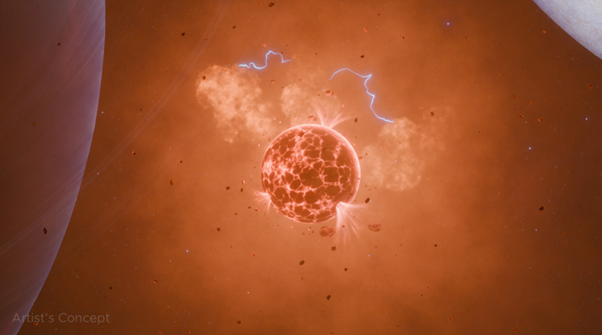The possibility of an Io-like moon around the exoplanet WASP-49b looks increasingly likely to be right, new research shows. The possible object is suspected of being peppered with volcanoes, creating a cloud of sodium that surrounds its planet. Although there have been claims for other exomoons (moons beyond the Solar System), these are now under considerable question, so this is probably the strongest evidence we have for such a first.
When the Voyager missions traveled to the outer Solar System to study the giant planets there, they found the moons that orbited them to be more diverse, and at least as interesting. As NASA prepares to launch a spacecraft to study one of those moons (and is working on a mission to another), astronomers ponder what might lie in orbit around the planets we have discovered circling other stars.
Any such moons will definitely be too small for us to see directly, even with the next generation of instruments. Theoretically we might detect the shadow they cast as they pass in front of their stars, but conflicting studies about the proposed satellite to Kepler-1625b show this isn’t an easy route. In 2019, a team including NASA astronomer Dr Apurva Oza proposed we might have seen evidence of an exomoon another way, suggesting a sodium cloud could be from its volcanoes.
Io’s abundant volcanism was one of the Voyagers’ great discoveries so we know moons close to giant planets can spit out a great deal of material this way. Moreover, we’re yet to find a likely alternative explanation for the detected sodium. Still, science seeks stronger evidence than that.

We don’t really know what the moon of WASP-49b looks like if it exists, but this artist took a guess.
Image Credit: NASA/JPL-Caltech
Oza, now at Caltech, has continued exploring the topic. He still doesn’t have absolute proof of an exomoon, but his team has made the case stronger by showing the sodium cloud is moving faster than WASP-49b. “We think this is a really critical piece of evidence,” Oza in a statement. “The cloud is moving in the opposite direction that physics tells us it should be going if it were part of the planet’s atmosphere.”
Oza and co-authors have also shown the sodium is being regularly refreshed, and is being emitted at an astonishing rate of up to 100,000 kilograms (220,000 pounds) per second.
WASP-49b is a “Hot Saturn” (a planet whose mass is similar to Saturn’s but has a temperature far higher than Venus). We have a fair idea of its composition based on light passing through its outer atmosphere as it passes in front of its star. Being mostly hydrogen and helium, there is no obvious way it could be expelling so much sodium. We also have no reason to think the star WASP-49, which has a similar composition, could be the source.
Io is volcanic because the combination of Jupiter’s gravity and the tug of the other Galilean moons are constantly stretching and squeezing it, creating enough heat to turn its interior molten. Some of what erupts from its volcanoes settles back down on the moon, but some escapes, only to be captured by Jupiter, creating a cloud around the planet that might look from a great distance a little like what we are spotting around WASP-49b.
WASP-49b is very much unlike Jupiter (or Saturn) in that it orbits a star not much cooler than the Sun in just 2.8 Earth days. Among other differences, that means that the gravitational pull of the star is so large that flexing doesn’t require any other large moons, although of course they could also theoretically exist.
Io spits out sodium, but even more sulfur dioxide and some other gases. Sodium is more easily illuminated in these conditions than most other elements, so it is possible the cloud around WASP-49b has a much more mixed composition, but only the sodium is visible from here.
Although an exomoon source appears to be the best explanation we have for the cloud, there is still one problem – you can’t keep producing sodium at a rate like that forever, or even for very long. WASP-49 is estimated to be around 7 billion years old, so these emissions are unlikely to have been an original feature of the system.
The longest outburst observed lasted 40 minutes. Earth’s volcanic eruptions can release billions of tonnes of material, but only a tiny proportion is sodium, and very little escapes the planet’s gravity. If Oza is right, the exomoon is losing mass so quickly that it will eventually disintegrate, and we are lucky to have spotted it before it does. “If there really is a moon there, it will have a very destructive ending,” Oza said.
On the other hand, sodium clouds have been detected around dozens of other exoplanets, the authors note, so if their conclusions are correct, volcanic moons could be a common feature of the universe.
The study is published open access in The Astrophysical Journal Letters
Source Link: Suspected First Moon Found Beyond The Solar System Is Probably Sodium-Spewing Volcanic World